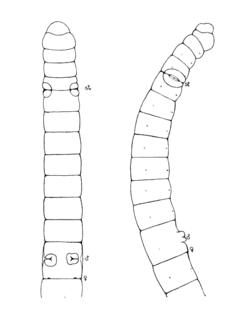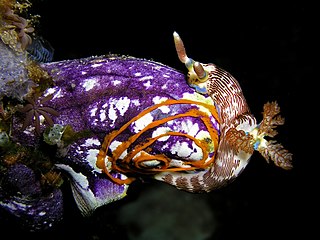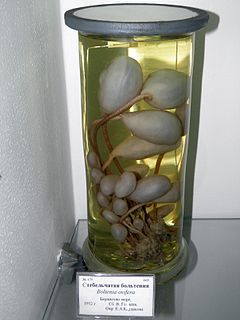
Oligochaeta is a subclass of animals in the phylum Annelida, which is made up of many types of aquatic and terrestrial worms, including all of the various earthworms. Specifically, oligochaetes comprise the terrestrial megadrile earthworms, and freshwater or semiterrestrial microdrile forms, including the tubificids, pot worms and ice worms (Enchytraeidae), blackworms (Lumbriculidae) and several interstitial marine worms.

The Megascolecidae are a large family of earthworms which has native representatives in Australia, New Zealand, both Southeast and East Asia, and North America. The most ancient lineages of the family show a Gondwanan distribution and have been used as evidence of continental drift. Members of the Pheretima group of genera are widely distributed around the tropics, much as some Lumbricidae are distributed through the temperate zones. Some North American native genera – e.g., Arctiostrotus, Argilophilus and Driloleirus – also belong to this family.

Ice worms are enchytraeid annelids of the genus Mesenchytraeus. The majority of the species in the genus are abundant in gravel beds or the banks of riverine habitats, but the most well-known members of the genus are found in glacial ice. They include the only annelid worms known to spend their entire lives in glacial ice, and some of the few metazoans to complete their entire life cycle at conditions below 0 °C (32 °F).

Pyura is a large genus of sessile ascidians that live in coastal waters at depths of up to 80 m (260 feet). Like all ascidians, Pyura are filter feeders. A few species, including Pyura chilensis are commercially fished.

Enchytraeidae is a family of microdrile oligochaetes. They resemble small earthworms and include both terrestrial species known as potworms that live in highly organic terrestrial environments, as well as some that are marine. The peculiar genus Mesenchytraeus is known as "ice worms", as they live in glaciers and will die if exposed to temperatures a few degrees above freezing. Apart from these, the best-known species is probably the Grindal Worm, which is commercially bred as aquarium fish food.

Stolidobranchia is an order of tunicates in the class Ascidiacea. The group includes both colonial and solitary animals. They are distinguished from other tunicates by the presence of folded pharyngeal baskets. This provides the etymology of their name: in ancient Greek, στολίς, ίδος means the "fold" of a cloth. Stolidobranchian sea squirts are also characterized by the complete absence of an abdomen. The abdominal organs of other tunicates are instead located to one side of the pharyngeal basket in this group.

Aplousobranchia is an order of sea squirts in the class Ascidiacea. They are colonial animals, and are distinguished from other sea squirts by the presence of relatively simple pharyngeal baskets. This provides the etymology of their name: in ancient greek, ἁ.πλοος-ους (ha.ploos-ous) means "simple". The posterior part of the abdomen contains the heart and gonads, and is typically larger than in other sea squirts.

Styelidae is a family of ascidian tunicates.

The Euphrosinidae are a family of polychaete worms. The name is from Greek Euphrosyne, meaning merriment; she was one of the three Graces.
Alloeocarpa is a genus of ascidian tunicates in the family Styelidae.
Gynandrocarpa is a genus of ascidian tunicates in the family Styelidae.

Metandrocarpa is a genus of ascidian tunicates in the family Styelidae.
Stolonica is a genus of ascidian tunicates in the family Styelidae.
Theodorella is a genus of ascidian tunicates in the family Styelidae.
Rhizomolgula is a genus of ascidian tunicates in the family Molgulidae.

Boltenia is a genus of ascidian tunicates in the family Pyuridae.
Fridericia is a genus of annelids of the family Enchytraeidae. The genus was described in 1889 by Wilhelm Michaelsen.
Andiorrhinus is a genus of earthworm in the family Glossoscolecidae. The genus contains 37 species subdivided into four subgenera.
Vejdovskyella is a genus of annelids, belonging to the family Naididae.
Eudrilus is a genus of annelids belonging to the family Eudrilidae.










